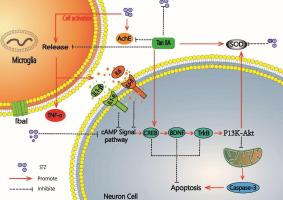当前位置:
X-MOL 学术
›
Neurosci. Lett.
›
论文详情
Our official English website, www.x-mol.net, welcomes your feedback! (Note: you will need to create a separate account there.)
Study on the role and mechanism of Tan IIA in Alzheimer’s disease based on CREB-BDNF-TrkB pathway
Neuroscience Letters ( IF 2.5 ) Pub Date : 2024-04-12 , DOI: 10.1016/j.neulet.2024.137769 Xiyong Xiang , Siyu Xia , Shan Li , Yirong Zeng , Lixuan Wang , Yan Zhou
Neuroscience Letters ( IF 2.5 ) Pub Date : 2024-04-12 , DOI: 10.1016/j.neulet.2024.137769 Xiyong Xiang , Siyu Xia , Shan Li , Yirong Zeng , Lixuan Wang , Yan Zhou

|
The occurrence and development of Alzheimer’s disease (AD) is closely related to neuronal loss, inflammatory response, cholinergic imbalance, and Tau protein hyperphosphorylation. Previous studies have confirmed that Streptozotocin (STZ) can be used to establish a rat model of AD by injecting it into the rat brain via the lateral ventricle. Our previous research showed that Danshentone IIA (Tan IIA) can improve cognitive dysfunction in rats caused by CC chemokine ligand 2, and network pharmacology results show that Tan IIA is very likely to improve AD symptoms through the cyclic adenosine monophosphate response element binding protein (CREB), brain-derived neurotrophic factor (BDNF), and tyrosine kinase receptor protein (TrkB) pathway. The results of the water maze experiment showed that after Tan IIA treatment, the escape latency of AD rats was shortened and the number of platform crossings increased; in the new object recognition experiment, the discrimination index of AD rats significantly increased after treatment; Nissl staining and Tunel staining results showed that Tan IIA increased the number of surviving neurons in the hippocampus of cognitively impaired rats and reduced neuronal apoptosis; Bielschowsky silver staining results showed that Tan IIA reduced neurofibrillary tangles (NFTs) in the AD rats; Tan IIA can reduce the inflammatory response and oxidative stress reaction in the hippocampus of AD rats, and at the same time reduce the activity of acetylcholinesterase. Tan IIA can significantly increase the expression of CREB, BDNF, TrkB in the hippocampal tissue of STZ-injured rats (P < 0.05). These data suggest that Tan IIA may upregulate the expression of the CREB-BDNF-TrkB signaling pathway in the hippocampus of brain tissue, produce anti-neuroinflammatory, antioxidant stress, inhibit neuronal apoptosis effects, and improve cholinergic neurotransmitter disorder induced by STZ, reduce the neuronal damage and learning and memory impairment caused by STZ in rats, and improve the cognitive function of rats.
中文翻译:

基于CREB-BDNF-TrkB通路研究Tan IIA在阿尔茨海默病中的作用及机制
阿尔茨海默病(AD)的发生发展与神经元丢失、炎症反应、胆碱能失衡、Tau蛋白过度磷酸化密切相关。既往研究证实,链脲佐菌素(STZ)通过侧脑室注射至大鼠脑内,可用于建立AD大鼠模型。我们前期的研究表明,丹参酮IIA(Tan IIA)可以改善CC趋化因子配体2引起的大鼠认知功能障碍,网络药理学结果表明,丹参酮IIA极有可能通过环磷酸腺苷反应元件结合蛋白(CREB)改善AD症状。 )、脑源性神经营养因子(BDNF)和酪氨酸激酶受体蛋白(TrkB)途径。水迷宫实验结果表明,Tan IIA治疗后,AD大鼠的逃避潜伏期缩短,平台穿越次数增加;在新物体识别实验中,治疗后AD大鼠的辨别指数显着提高;尼氏染色和Tunel染色结果显示,Tan IIA增加认知障碍大鼠海马存活神经元数量,减少神经元凋亡; Bielschowsky 银染色结果表明 Tan IIA 减少了 AD 大鼠的神经原纤维缠结 (NFT); Tan IIA可减轻AD大鼠海马的炎症反应和氧化应激反应,同时降低乙酰胆碱酯酶的活性。 Tan IIA能显着增加STZ损伤大鼠海马组织中CREB、BDNF、TrkB的表达(P < 0.05)。这些数据提示,Tan IIA可能上调脑组织海马CREB-BDNF-TrkB信号通路的表达,产生抗神经炎症、抗氧化应激、抑制神经元凋亡作用,改善STZ引起的胆碱能神经递质紊乱,减轻STZ引起大鼠神经元损伤和学习记忆障碍,并改善大鼠认知功能。
更新日期:2024-04-12
中文翻译:

基于CREB-BDNF-TrkB通路研究Tan IIA在阿尔茨海默病中的作用及机制
阿尔茨海默病(AD)的发生发展与神经元丢失、炎症反应、胆碱能失衡、Tau蛋白过度磷酸化密切相关。既往研究证实,链脲佐菌素(STZ)通过侧脑室注射至大鼠脑内,可用于建立AD大鼠模型。我们前期的研究表明,丹参酮IIA(Tan IIA)可以改善CC趋化因子配体2引起的大鼠认知功能障碍,网络药理学结果表明,丹参酮IIA极有可能通过环磷酸腺苷反应元件结合蛋白(CREB)改善AD症状。 )、脑源性神经营养因子(BDNF)和酪氨酸激酶受体蛋白(TrkB)途径。水迷宫实验结果表明,Tan IIA治疗后,AD大鼠的逃避潜伏期缩短,平台穿越次数增加;在新物体识别实验中,治疗后AD大鼠的辨别指数显着提高;尼氏染色和Tunel染色结果显示,Tan IIA增加认知障碍大鼠海马存活神经元数量,减少神经元凋亡; Bielschowsky 银染色结果表明 Tan IIA 减少了 AD 大鼠的神经原纤维缠结 (NFT); Tan IIA可减轻AD大鼠海马的炎症反应和氧化应激反应,同时降低乙酰胆碱酯酶的活性。 Tan IIA能显着增加STZ损伤大鼠海马组织中CREB、BDNF、TrkB的表达(P < 0.05)。这些数据提示,Tan IIA可能上调脑组织海马CREB-BDNF-TrkB信号通路的表达,产生抗神经炎症、抗氧化应激、抑制神经元凋亡作用,改善STZ引起的胆碱能神经递质紊乱,减轻STZ引起大鼠神经元损伤和学习记忆障碍,并改善大鼠认知功能。



























 京公网安备 11010802027423号
京公网安备 11010802027423号